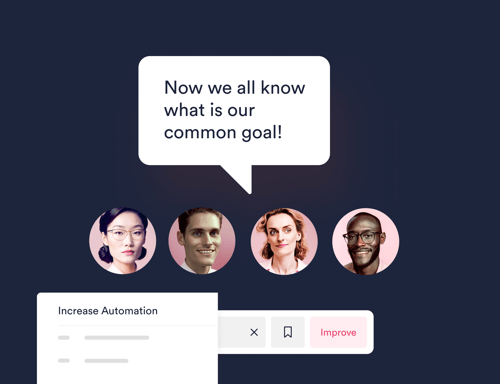Get ITXM Certified
Free ITXM Foundation Course and Certification available.
Before you can start to make actions and decisions, you need to have a clear objectives for IT teams.

The title above might make you smile, but understanding the objective is essential for people to know why they should care. That is why it is so important to clearly define the desired short/long-term outcomes for IT initiatives.
Clear objectives drive coherent action and reduce hesitation when individuals make choices in their daily work. They also create a common focus without micro-management between teams and individual IT workers. This enables time and effort to be self-guided toward the higher-level objective.
Contributors:
Sakari Kyrö / HappySignals
Pasi Nikkanen / HappySignals
Reading time:
5 minutes
Level:
Strategic
Updated:
2nd February 2023
Objectives are guiding principles like “expose the watermelon,” “increase automation,” or “improve cooperation with partners.” IT Experience Management Objectives should not be created in a silo by a single individual but agreed upon with both sides of the table to drive focus and coordination efforts.
Without shared objectives, having alignment between IT teams can require micro-management. With clear goals and continuous experience data, teams can work more autonomously, knowing they are working towards something important on a higher level.
Regularly reiterating the current objective during each Monthly Experience Meeting is crucial, as it reinforces the goal in the minds of each team member. This helps to establish a culture of prioritizing the objective and working towards it naturally.
You should set an objective before you start to work with Experience Data. Ideally, the objectives of IT Experience Management have been defined together with business stakeholders in advance. Setting Objectives is an essential step before setting numeric goals and defining KPIs. Objectives give you guidance and focus for monthly and weekly meetings and improve the quality of IT decisions.
"Your first objective can be as simple as just understanding how end-users experience your IT services, then you can set Objectives to Improve that." - Pasi Nikkanen, HappySignals
Objectives are big-picture goals that support IT in moving in a common direction that enables business outcomes beyond the typical IT limits. When thinking about objectives, imagine if the top leadership in IT would go in front of the board and say, "This year, we will focus on [enter the objective]." Is the objective on a high enough level?
While objectives may not have an end date, keeping them up to date is essential, as highlighted above.
Think about the objective of "Improve collaboration with IT partners." Many different actions on various levels can contribute to improving that relationship. Those are the individual initiatives that contribute towards the objective. Will you ever come to a point where collaboration is perfect in every way? Probably not. Would you be able to complete initiatives that show clear improvement over time? Absolutely.
This allows IT teams to independently consider their role in co-creating value while evaluating improvement initiatives against higher-level objectives.
